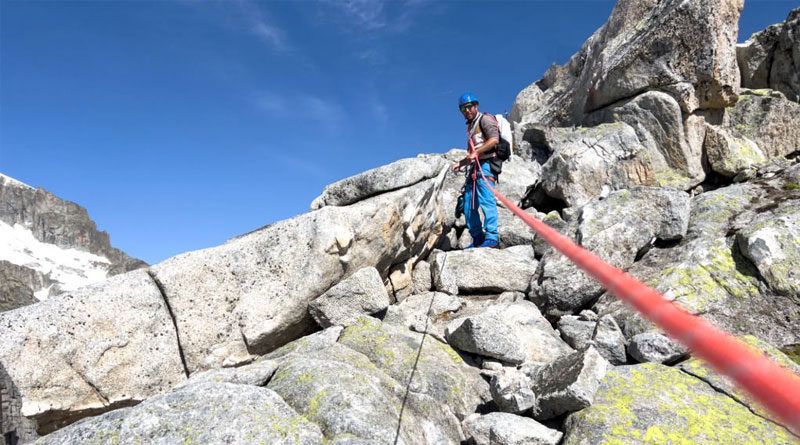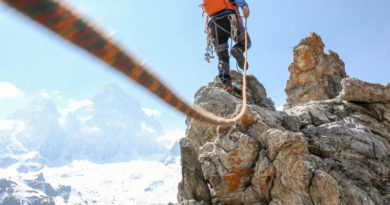Top Rope vs. Lead Climbing: A Comparison
Whether you are a beginner or an experienced climber, understanding the differences between the top rope and lead climbing is important. Top rope climbing involves climbing up a route while securely attached to a rope that is anchored at the top of the climbing surface. Lead climbing, on the other hand, involves ascending a route while attaching yourself to the rope as you climb. This, however, requires a higher level of technical skill and is more dangerous.
This blog post will go over the differences between the top rope and lead climbing, their benefits and drawbacks, and which one might be better suited for you based on your skill level, experience, and climbing goals. Climbing can be a dangerous activity that should only be attempted with proper training, equipment, and safety precautions.
Top Rope Climbing
Top rope climbing, as I mentioned above, is a climbing style in which you ascend a route while attached to a rope, which is then anchored at the top of the climbing surface. The rope is usually fed through an anchor system at the summit of the climb and down to the climber. The belayer is tied to the rope’s bottom end with a harness and a belay device. The belayer uses the belay device to control the slack in the rope and catch the climber if you fall.
Pros and Cons
One of the primary benefits of top rope climbing is that it is a relatively safe form of climbing because you are always securely attached to the rope. This makes it an excellent choice if you are a beginner or new to a specific climbing area. Also, because the rope is already in place, there is no need to worry about rigging or anchoring the climb, which can be time-consuming and mentally challenging.
However, there are some disadvantages to top rope climbing. The route is predetermined because the rope is fixed at the top of the climb and you cannot deviate from it. This can limit the variety and difficulty of climbs available. Furthermore, the rope can cause friction and drag, making certain routes more difficult to climb.
Safety Considerations
While top rope climbing is generally regarded as a safe style of climbing, there are some precautions to take. Before climbing, it is critical to anchor the rope at the top of the climb properly and to inspect the anchor and rope for signs of wear or damage. Furthermore, both the climber and the belayer should receive training in proper safety techniques, such as how to tie into the rope and use a belay device.
Tips for Beginners
Top rope climbing is a great way for beginners to get started in the sport. To get started, look for a qualified instructor or guide who can teach you the fundamentals of climbing, such as how to tie into the rope, use a belay device, and climb safely. It is critical for you to start with easy climbs and gradually progress to more difficult routes. Finally, it is also critical for you and your partner to communicate clearly at all times.
Lead Climbing
Lead climbing is relatively a more advanced style of climbing. You ascend a route while attaching to the rope as you go. In contrast to top rope climbing, the rope is not already in place and must be clipped into protection points along the way such as bolts, nuts, or cams. As you ascend, the belayer, who is typically anchored to the ground or a nearby surface, feeds the rope through a belay device, taking up the slack and catching the climber in the event of a fall.
Pros and Cons
Lead climbing has several advantages over top rope climbing. It gives the climber more freedom in route selection because he or she is not restricted to a pre-set line. It also presents a greater challenge because the climber must have a higher level of technical skill, endurance, and mental focus while ascending to clip into protection points. Finally, because the climber is responsible for the climb’s success, lead climbing can be more satisfying and rewarding.
However, there are several disadvantages to lead climbing. It is a more advanced climbing style that requires more technical skill and training to complete safely. Furthermore, because the climber must manage the rope, clip into protection points, and ascend the climb all at the same time, it can be more mentally and physically demanding. Finally, lead climbing increases the risk of injury in the event of a fall because the climber will fall twice as far as the last protection point.
Safety Considerations
Lead climbing is a riskier style of climbing, and there are several safety precautions to take. Proper equipment use, such as ropes, harnesses, and belay devices, as well as proper technique in clipping into protection points and managing the rope, is critical. It is also critical to inspect protection points for damage or wear and to employ redundant systems as needed. Finally, both the climber and the belayer should be trained in proper safety and communication techniques.
Tips for Beginners
If you’re new to lead climbing, it’s best to start with easy routes and work your way up to more difficult climbs. It is also critical to train with a qualified instructor or guide who can teach you proper lead climbing techniques, such as how to clip into protection points and manage the rope. It is also critical to climb with someone you trust and to communicate clearly throughout the climb. Finally, always wear appropriate safety equipment, such as a helmet, and be aware of the dangers of lead climbing.
Which One to Choose?
When deciding between top rope climbing and lead climbing, there are several factors to consider. These include personal preference, skill level and experience, and climbing goals.
Personal Preference
Personal preference is critical. Some climbers prefer top rope climbing for its simplicity and security, while others enjoy the added challenge and freedom of lead climbing. It is critical to select a climbing style that is both comfortable and enjoyable for you.
Skill Level and Experience
Top rope climbing is generally regarded as a more beginner-friendly style of climbing than lead climbing because it requires less technical skill and is less mentally and physically demanding. Lead climbing, on the other hand, needs a higher level of technical skill, experience, and mental concentration. If you are new to climbing or have little experience, you should probably start with top rope climbing before moving on to lead climbing.
Climbing Goals
Finally, your climbing goals may influence your decision between the top rope and lead climbing. If you want to climb longer, more challenging routes, lead climbing may be the best option because it gives you more freedom in selecting a line and a greater sense of accomplishment. If you want to improve your climbing technique or fitness, top rope climbing may be a better option because it allows you to focus on climbing movement rather than rope management.
Conclusion
To conclude, top rope climbing and lead climbing are two popular rock climbing styles, each with its own set of challenges and rewards. Top rope climbing is generally regarded as a safer and more beginner-friendly climbing style, whereas lead climbing requires a higher level of technical skill and experience. Climbers should consider personal preference, skill level and experience, and climbing goals when deciding on a style. Regardless of the style chosen, safety should always take precedence. With proper training, equipment, and technique, both climbing styles can be exhilarating and fulfilling activities for climbers of all levels.




